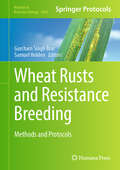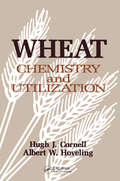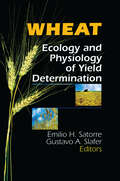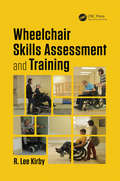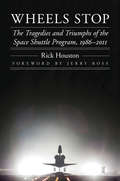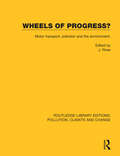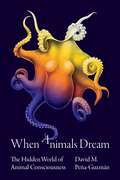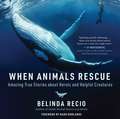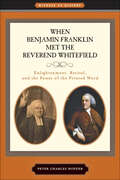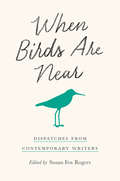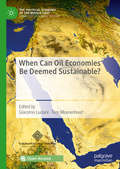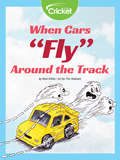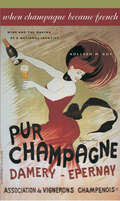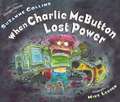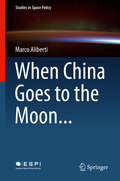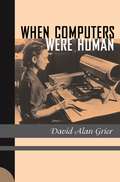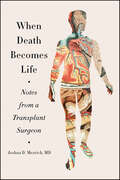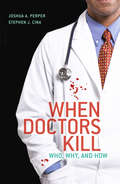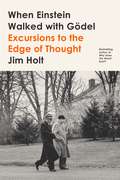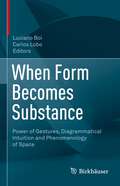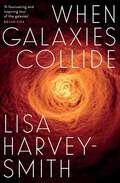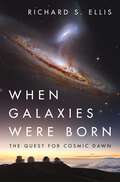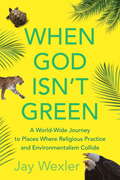- Table View
- List View
Wheat Rusts and Resistance Breeding: Methods and Protocols (Methods in Molecular Biology #2898)
by Gurcharn Singh Brar Samuel HoldenThis detailed volume collects techniques for increasing our understanding of wheat rust pathogens, the host plant, and the interactions between the two. Beginning with routine and advanced tools used for pathogen surveillance, characterization, and field assessment of germplasm for resistance, the book continues with sections on genetic analysis and breeding for rust resistance, as well as rust management through fungicidal approaches. Written for the highly successful Methods in Molecular Biology series, chapters include introductions to their respective topics, lists of the necessary materials and reagents, step-by-step and readily reproducible laboratory protocols, and tips on troubleshooting and avoiding known pitfalls. Authoritative and practical, Wheat Rusts and Resistance Breeding: Methods and Protocols serves as an ideal guide for established researchers looking to familiarize themselves with new innovations and for new researchers working to strengthen their understanding of rust pathogens.
Wheat: Chemistry and Utilization
by Hugh Cornell Albert W. Hoveling"This book meets the need for a comprehensive, up-to-date review of wheat chemistry, processing and uses. It provides the reader with extensive new information on wheat components that will be useful in better commercial utilization of wheat and the formulation of new and upgraded wheat-based food products. The book serves as a one-volume information resource for all those involved in the research, development, formulation, and evaluation of wheat-based food products. From the Authors' PrefaceWheat continues to be one of the world's most important grains, especially as a food, where the unique properties of its products can be utilized to advantage. It provides an excellent example of a natural product from which a wide range of useful by-products can be made. This book discusses the components of the wheat kernel, which provide interesting examples of study of carbohydrate and protein chemistry, as well as lipids, minerals and vitamins. This book should serve as a useful reference for the cereal chemist, as well as chemists and food technologists in those industries in which by-products of flour are used, e.g., the confectionery industry in which modified starches and starch syrups are used. In addition, nutritionists, dieticians, and many kinds of researchers will find chapters of interest. Particular attention is given to particle-size determinations, an important area in food processing, and to the role of wheat proteins in gluten intolerance and wheat allergy. . . . Both the milling of wheat and flour quality are discussed in order to give the reader an idea of the distribution of the major components and the importance of proper size reduction. The book also has a chapter on wet milling of wheat flour . . . and chapters on the properties and uses of wheat starch, starch syrups, and chemically modified wheat starch.
Wheat: Ecology and Physiology of Yield Determination
by Gustavo A Slafer E H SatorreDiscussing the latest processes involved in researching yield generation, Wheat: Ecology and Physiology of Yield Determination will help you design various types of crop production systems for maximum yield. Featuring information on developing high-yielding, low-input, and quality-oriented systems, this book offers you both physiological and ecological approaches that will help you understand the crop as well as increase its production. Discussing aspects of wheat growth for specific regions around the world, Wheat provides you with information that will improve the size and quality of your crops, including: how temperature, vernalization, and the photoperiod affect the development of wheat using the correct amount of nitrogen fertilizers for wheat crops an explanation of the reproduction and nitrogen cycles of wheat how elements and conditions such as lipids, proteins, nitrogen, and climate enhance grain quality estimating and determining optimal sowing dates examining factors that may affect wheat yield-density relationships, such as planting arrangement and date of sowing preventing seed decay and examining effects of mildews and leaf blights examining historical trends of the crop to see what further research needs to be done You'll also receive information on the genetic gains in wheat research that are improving the physiological traits and numerical components of this essential grain. Within Wheat, you'll find data and methods from international experts in the field that will improve the yield and growth of the world's most important crop.
Wheelchair Skills Assessment and Training (Rehabilitation Science in Practice Series)
by R. Lee KirbyThis book provides a wide spectrum of readers with comprehensive but easily understandable protocols for the assessment and training of wheelchair skills. The Wheelchair Research Team at Dalhousie University and the Capital District Health Authority in Halifax (lead by the author) have focused on wheelchair safety and performance for three decades, as exemplified through the Wheelchair Skills Program. This is considered the top such program in the world. This new book is largely based on this program which has been accessed and utilized by over 75,000 people in 177 countries since 2007.
Wheels Stop: The Tragedies and Triumphs of the Space Shuttle Program, 1986-2011 (Outward Odyssey: A People's History of Spaceflight)
by Rick HoustonHumanity&’s first reusable spacecraft and the most complex machine ever built, NASA&’s Space Shuttle debuted with great promise and as a dependable source of wonder and national pride. But with the Challenger catastrophe in 1986, the whole Space Shuttle program came into question, as did NASA itself, so long an institution that was seemingly above reproach. Wheels Stop tells the stirring story of how, after the Challenger disaster, the Space Shuttle not only recovered but went on to perform its greatest missions. From the Return to Flight mission of STS-26 in 1988 to the last shuttle mission ever on STS-135 in 2011, Wheels Stop takes readers behind the scenes as the shuttle&’s crews begin to mend Cold War tensions with the former Soviet Union, conduct vital research, deploy satellites, repair the Hubble Space Telescope, and assist in constructing the International Space Station. It also tells the heart-wrenching story of the Columbia tragedy and the loss of the magnificent STS-107 crew.As complex as the shuttle was, the people it carried into orbit were often more so—and this is their story, too. Close encounters with astronauts, flight controllers, and shuttle workers capture the human side of the Space Shuttle&’s amazing journey—and invite readers along for the ride. Browse more spaceflight books at upinspace.org.Purchase the audio edition.
Wheels of Progress?: Motor transport, pollution and the environment.
by J. RoseOriginally published in 1973 and based on papers published in The International Journal of Environmental Studies, this book discusses the impact of road vehicles on the environment. Particular stress is laid on the design of towns and vehicles, economic problems associated with these, the responsibility of planners and the integration of transport planning and environmental planning at local, regional and national levels. Subsequent sections cover the science of accident research and legislation, particularly dealing with global pollution control. Many of the problems discussed remain as pressing today as when this book was first published.
When Animals Dream: The Hidden World of Animal Consciousness
by David M. Peña-GuzmánA spellbinding look at the philosophical and moral implications of animal dreamingAre humans the only dreamers on Earth? What goes on in the minds of animals when they sleep? When Animals Dream brings together behavioral and neuroscientific research on animal sleep with philosophical theories of dreaming. It shows that dreams provide an invaluable window into the cognitive and emotional lives of nonhuman animals, giving us access to a seemingly inaccessible realm of animal experience.David Peña-Guzmán uncovers evidence of animal dreaming throughout the scientific literature, suggesting that many animals run “reality simulations” while asleep, with a dream-ego moving through a dynamic and coherent dreamscape. He builds a convincing case for animals as conscious beings and examines the thorny scientific, philosophical, and ethical questions it raises. Once we accept that animals dream, we incur a host of moral obligations and have no choice but to rethink our views about who animals are and the interior lives they lead.A mesmerizing journey into the otherworldly domain of nonhuman consciousness, When Animals Dream carries profound implications for contemporary debates about animal cognition, animal ethics, and animal rights, challenging us to regard animals as beings who matter, and for whom things matter.
When Animals Rescue: Amazing True Stories about Heroic and Helpful Creatures
by Belinda RecioA Collection of True Tales of Animal Empathy and Altruism that will Inspire Us to Reflect on Our Own Human Nature What do stories about humpback whales protecting a biologist from a shark, a pride of lions rescuing a girl from kidnappers, gorillas working together to dismantle poacher snares, a parrot warding off an attacker in a park, a chimpanzee consoling a human, and an elephant trying to rescue a baby rhino tell us about animal nature? And what might they suggest about our very own human nature? Until just a few decades ago, there were only a few animals reported to behave empathetically and altruistically. More recently, the list of species who have been observed behaving in compassionate, helpful, and caring ways has grown exponentially, ranging from rats to elephants. Rescued by a Whale presents dozens of astonishing and heart-warming stories about animals, such as chickens, horses, dolphins, and wolves, who engage in acts of helpful kindness. During a time in history when studies show that human empathy is decreasing, our knowledge about animal empathy is increasing. These true tales of heroism, kindness, and compassion suggest that we have far more in common with other animals than we once believed and provocatively suggest that what&’s best about our human natures just might be our animal natures.
When Benjamin Franklin Met the Reverend Whitefield: Enlightenment, Revival, and the Power of the Printed Word (Witness to History)
by Peter Charles HofferIn the 1740s, two quite different developments revolutionized Anglo-American life and thought—the Enlightenment and the Great Awakening. This book takes an encounter between the paragons of each movement—the printer and entrepreneur Benjamin Franklin and the British-born revivalist George Whitefield—as an opportunity to explore the meaning of the beginnings of modern science and rationality on one hand and evangelical religious enthusiasm on the other.There are people who both represent the times in which they live and change them for the better. Franklin and Whitefield were two such men. The morning that they met, they formed a long and lucrative partnership: Whitefield provided copies of his journals and sermons, Franklin published them. So began one of the most unique, mutually profitable, and influential friendships in early American history. By focusing this study on Franklin and Whitefield, Peter Charles Hoffer defines with great precision the importance of the Anglo-American Atlantic World of the eighteenth century in American history. With a swift and persuasive narrative, Hoffer introduces readers to the respective life story of each man, examines in engaging detail the central themes of their early writings, and concludes with a description of the last years of their collaboration. Franklin’s and Whitefield’s intellectual contributions reach into our own time, making Hoffer's readable and enjoyable account of these extraordinary men and their extraordinary friendship relevant today.Also in the Witness to History seriesThe Huron-Wendat Feast of the Dead: Indian-European Encounters in Early North America by Erik R. SeemanKing Philip's War: Colonial Expansion, Native Resistance, and the End of Indian Sovereignty by Daniel R. MandellThe Caning of Charles Sumner: Honor, Idealism, and the Origins of the Civil War by Williamjames Hull HofferBloodshed at Little Bighorn: Sitting Bull, Custer, and the Destinies of Nations by Tim Lehman
When Benjamin Franklin Met the Reverend Whitefield: Enlightenment, Revival, and the Power of the Printed Word (Witness to History)
by Peter Charles HofferThe story of a unique friendship in colonial America between a Founding Father and a founder of the evangelical movement. In the 1740s, two very different developments revolutionized Anglo-American life and thought—the Enlightenment and the Great Awakening. This book takes an encounter between the paragons of each movement—the printer and entrepreneur Benjamin Franklin and the British-born revivalist George Whitefield—as an opportunity to explore the meaning of the beginnings of modern science and rationality on one hand and evangelical religious enthusiasm on the other. There are people who both represent the times in which they live and change them for the better. Franklin and Whitefield were two such men. The morning that they met, they formed a long and lucrative partnership: Whitefield provided copies of his journals and sermons, Franklin published them. So began a unique, mutually profitable, and influential friendship. By focusing this study on Franklin and Whitefield, Peter Charles Hoffer defines with great precision the importance of the Anglo-American Atlantic World of the eighteenth century in American history. With a swift and persuasive narrative, Hoffer introduces readers to the respective life story of each man, examines in engaging detail the central themes of their early writings, and concludes with a description of the last years of their collaboration. Franklin&’s and Whitefield&’s intellectual contributions reach into our own time, making Hoffer&’s enjoyable account of these extraordinary men and their extraordinary friendship relevant today.</
When Birds Are Near: Dispatches from Contemporary Writers
In this dazzling literary collection, writers explore and celebrate their lives with and love for birds—detailing experiences from Alaska to Bermuda, South Dakota to Panama. In When Birds Are Near, fresh new voices as well as seasoned authors offer tales of adventure, perseverance, and fun, whether taking us on a journey down Highway 1 to see a rare California Condor, fighting the destruction of our grasslands, or simply watching the feeder from a kitchen window.But these essays are more than just field notes. The authors reflect on love, loss, and family, engaging a broad array of emotions, from wonder to amusement. As Rob Nixon writes, "Sometimes the best bird experiences are defined less by a rare sighting than by a quality of presence, some sense of overall occasion that sets in motion memories of a particular landscape, a particular light, a particular choral effect, a particular hiking partner." Or, as the poet Elizabeth Bradfield remarks, "We resonate with certain animals, I believe, because they are a physical embodiment of an answer we are seeking. A sense of ourselves in the world that is nearly inexpressible." When Birds Are Near gives us the chance to walk alongside these avid appreciators of birds and reflect on our own interactions with our winged companions.Contributors: Christina Baal, Thomas Bancroft, K. Bannerman, R. A. Behrstock, Richard Bohannon, Elizabeth Bradfield, Christine Byl, Susan Cerulean, Sara Crosby, Jenn Dean, Rachel Dickinson, Katie Fallon, Jonathan Franzen, Andrew Furman, Tim Gallagher, David Gessner, Renata Golden, Ursula Murray Husted, Eli J. Knapp, Donald Kroodsma, J. Drew Lanham, John R. Nelson, Rob Nixon, Jonathan Rosen, Alison Townsend, Alison Világ
When Brains Dream: Exploring The Science And Mystery Of Sleep
by Antonio Zadra Robert StickgoldA comprehensive, eye-opening exploration of what dreams are, where they come from, what they mean, and why we have them. Questions on the origins and meaning of dreams are as old as humankind, and as confounding and exciting today as when nineteenth-century scientists first attempted to unravel them. Why do we dream? Do dreams hold psychological meaning or are they merely the reflection of random brain activity? What purpose do dreams serve? When Brains Dream addresses these core questions about dreams while illuminating the most up-to-date science in the field. Written by two world-renowned sleep and dream researchers, it debunks common myths?that we only dream in REM sleep, for example—while acknowledging the mysteries that persist around both the science and experience of dreaming. Antonio Zadra and Robert Stickgold bring together state-of-the-art neuroscientific ideas and findings to propose a new and innovative model of dream function called NEXTUP—Network Exploration to Understand Possibilities. By detailing this model’s workings, they help readers understand key features of several types of dreams, from prophetic dreams to nightmares and lucid dreams. When Brains Dream reveals recent discoveries about the sleeping brain and the many ways in which dreams are psychologically, and neurologically, meaningful experiences; explores a host of dream-related disorders; and explains how dreams can facilitate creativity and be a source of personal insight. Making an eloquent and engaging case for why the human brain needs to dream, When Brains Dream offers compelling answers to age-old questions about the mysteries of sleep.
When Can Oil Economies Be Deemed Sustainable? (The Political Economy of the Middle East)
by Giacomo Luciani Tom MoerenhoutThis open access book questions the stereotype depicting all Gulf (GCC) economies as not sustainable, and starts a critical discussion of what these economies and polities should do to guarantee themselves a relatively stable future.Volatile international oil markets and the acceleration of the energy transition has challenged the notion that oil revenues are sufficient to sustain oil economies in the near to medium term. But what is the meaning of economic sustainability? The book discusses the multiple dimensions of the concept: economic diversification, continuing value of resources, taxation and fiscal development, labor market sustainability, sustainable income distribution, environmental sustainability, political order (democracy or authoritarianism) and sustainability, regional integration.The overarching message in this book is that we should move on from the simplistic branding of the Gulf economies as unsustainable and tackle the details of which adaptations they might need to undertake.
When Cars Fly Around the Track
by Nick D'Alto Tim OliphantAuto racing is all about aerodynamics. Racecars use two different forces, lift and drag, to fly around the track. Find out how the cars use these forces, and then “fly” your own racecar with a fun experiment!
When Champagne Became French: Wine and the Making of a National Identity (The Johns Hopkins University Studies in Historical and Political Science #121)
by Kolleen M. GuyWinner of the 2002 Manuscript Award from Phi Alpha ThetaWinner of the Gourmand World Cookbook Awards for English Wine, Best Wine History Book, and Best Book on French WineWinner of the Clicquot Wine Book of the Year CompetitionWinner of the Outstanding Manuscript Award from Phi Alpha Theta, this work explains how nationhood emerges by viewing countries as cultural artifacts, a product of "invented traditions." In the case of France, scholars sharply disagree, not only over the nature of French national identity but also over the extent to which diverse and sometimes hostile provincial communities became integrated into the nation. In When Champagne Became French: Wine and the Making of a National Identity, Kolleen M. Guy offers a new perspective on this debate by looking at one of the central elements in French national culture—luxury wine—and the rural communities that profited from its production.Focusing on the development of the champagne industry between 1820 and 1920, Guy explores the role of private interests in the creation of national culture and in the nation-building process. Drawing on concepts from social and cultural history, she shows how champagne helped fuel the revolution in consumption as social groups searched for new ways to develop cohesion and to establish status. By the end of the nineteenth century, Guy concludes, the champagne-producing provinces in the department of Marne had developed a rhetoric of French identity that promoted its own marketing success as national. This ability to mask local interests as national concerns convinced government officials of the need, at both national and international levels, to protect champagne as a French patrimony.
When Charlie McButton Lost Power
by Suzanne Collins Mike LesterAn electifying picture book from the author of The Hunger Games. Charlie McButton likes computer games so much, he never plays with anything else. When a thunderstorm knocks out the electricity, his tech empire comes tumbling down, and his whole world loses power. He needs batteries--FAST. But the only triple A's he can find are in his little sister's talking doll. Will he resort to desperate measures and cause his little sister to have a meltdown of her own? Or will be snap out of his computer craze long enough to realize he can have fun with her, even without batteries? Suzanne Collins, author of the bestselling Hunger Games trilogy, and award-winning illustrator Mike Lester team up for a hilarious and timely tale that will crack up young computer addicts and those who love them.
When China Goes to the Moon...
by Marco AlibertiThis book is about China's ambitions in its most complex and internationally visible space endeavor, namely its human space exploration programme. It provides a comprehensive reflection on China´s strategic direction and objectives in space, including in particular those set forth in its human spaceflight programme and analyses the key domestic and external factors affecting the country's presumed manned lunar ambitions. The objective of the book is to disentangle the opportunities and challenges China´s space ambitions are creating for other spacefaring nations and for Europe in particular. It therefore includes an in-depth analysis of possible European postures towards China in space exploration and seeks to stimulate a debate on future space strategies in the broader context of world politics.
When Computers Were Human
by David Alan GrierBefore Palm Pilots and iPods, PCs and laptops, the term "computer" referred to the people who did scientific calculations by hand. These workers were neither calculating geniuses nor idiot savants but knowledgeable people who, in other circumstances, might have become scientists in their own right. When Computers Were Human represents the first in-depth account of this little-known, 200-year epoch in the history of science and technology. Beginning with the story of his own grandmother, who was trained as a human computer, David Alan Grier provides a poignant introduction to the wider world of women and men who did the hard computational labor of science. His grandmother's casual remark, "I wish I'd used my calculus," hinted at a career deferred and an education forgotten, a secret life unappreciated; like many highly educated women of her generation, she studied to become a human computer because nothing else would offer her a place in the scientific world. The book begins with the return of Halley's comet in 1758 and the effort of three French astronomers to compute its orbit. It ends four cycles later, with a UNIVAC electronic computer projecting the 1986 orbit. In between, Grier tells us about the surveyors of the French Revolution, describes the calculating machines of Charles Babbage, and guides the reader through the Great Depression to marvel at the giant computing room of the Works Progress Administration. When Computers Were Human is the sad but lyrical story of workers who gladly did the hard labor of research calculation in the hope that they might be part of the scientific community. In the end, they were rewarded by a new electronic machine that took the place and the name of those who were, once, the computers.
When Death Becomes Life: Notes from a Transplant Surgeon
by Joshua D. MezrichA transplant surgeon's “visceral tale of hearts and bones, surgical bravura, and the ‘web of transplantation’ that binds people who might never meet” (Nature).At the University of Wisconsin, Dr. Joshua Mezrich creates life from loss, transplanting organs from one body to another. In this intimate, profoundly moving work, he illuminates the extraordinary field of transplantation that enables this kind of miracle to happen every day. Mezrich examines more than a hundred years of remarkable medical breakthroughs, connecting this history with the inspiring and heartbreaking stories of his transplant patients. He introduces the maverick surgeons who made transplantation a reality. And he takes us inside the operating room and unlocks the wondrous process of transplant surgery, a delicate, intense ballet requiring precise timing, breathtaking skill, and at times, creative improvisation.When Death Becomes Life also engages in fascinating ethical and philosophical debates: How much risk should a healthy person be allowed to take to save someone she loves? Should a patient suffering from alcoholism receive a healthy liver? What defines death, and what role did organ transplantation play in that definition? The human story behind the most exceptional medicine of our time, Mezrich’s riveting book is a poignant reminder that a life lost can also offer the hope of a new beginning.“Outstanding … . . . Medical memoirs have become a significant genre over the past two decades, and this one ranks near the top, in a class that includes the best.” — Kirkus Reviews (starred review)“Braids unflinching medical history with frank clinical memoir. . . . there are no demigods in the world of transplant, just especially ambitious and unqueasy humans.” — Wall Street Journal“A clear and compelling account of the grueling daily work, the spellbinding history and the unsettling ethical issues that haunt this miraculous lifesaving treatment. Mezrich's compassionate and honest voice, punctuated by a sharp and intelligent wit, render the enormous subject not just palatable but downright engrossing.” —Pauline Chen, author of Final Exam: A Surgeon’s Reflections on Mortality“Fascinating . . .Mezrich weaves in the history, ethics, and technical grit of how doctors and patients navigate this miraculous second chance at life.” — Danielle Ofri, M.D., Ph.D., author of What Patients Say, What Doctors Hear
When Doctors Kill
by Joshua A. Perper Stephen J. CinaTraditionally, physicians have held a position of honor, trust, and respect in society. They are, however, fallible humans capable of making errors resulting in the unintentional death of their patients. They may also be instruments of evil submitting their patients to horrific medical experimentation, torture, and death. When Doctors Kill: Who, Why, and How will review the roots of medical ethics and examples of its perversion by murderous physicians. Physicians are generally viewed as caring and compassionate members of society, dedicated individuals charged with healing the helpless. The public is invariably fascinated when one of the "good guys" turns bad. When Doctors Kill: Who, Why, and How will examine health care professionals involved in serial killings, unethical human experimentation, and mass murder. The moral quagmire involved in the practice of modern medicine, including abortion, "mercy killings", and euthanasia, will also be discussed. The authors, Joshua A. Perper and Stephen J. Cina, are two highly published forensic pathologists who are trained to convert complex medical and scientific data into an easily digestible form suitable to the lay public. This heavily researched book can serve as a reference or as a time-killer on a long plane ride.
When Einstein Walked with Gödel: Excursions to the Edge of Thought
by Jim HoltFrom Jim Holt, the New York Times bestselling author of Why Does the World Exist?, comes an entertaining and accessible guide to the most profound scientific and mathematical ideas of recent centuries in When Einstein Walked with Gödel: Excursions to the Edge of Thought.Does time exist? What is infinity? Why do mirrors reverse left and right but not up and down? In this scintillating collection, Holt explores the human mind, the cosmos, and the thinkers who’ve tried to encompass the latter with the former. With his trademark clarity and humor, Holt probes the mysteries of quantum mechanics, the quest for the foundations of mathematics, and the nature of logic and truth. Along the way, he offers intimate biographical sketches of celebrated and neglected thinkers, from the physicist Emmy Noether to the computing pioneer Alan Turing and the discoverer of fractals, Benoit Mandelbrot. Holt offers a painless and playful introduction to many of our most beautiful but least understood ideas, from Einsteinian relativity to string theory, and also invites us to consider why the greatest logician of the twentieth century believed the U.S. Constitution contained a terrible contradiction—and whether the universe truly has a future.
When Form Becomes Substance: Power of Gestures, Diagrammatical Intuition and Phenomenology of Space
by Carlos Lobo Luciano BoiThis interdisciplinary volume collects contributions from experts in their respective fields with as common theme diagrams.Diagrams play a fundamental role in the mathematical visualization and philosophical analysis of forms in space. Some of the most interesting and profound recent developments in contemporary sciences, whether in topology, geometry, dynamic systems theory, quantum field theory or string theory, have been made possible by the introduction of new types of diagrams, which, in addition to their essential role in the discovery of new classes of spaces and phenomena, have contributed to enriching and clarifying the meaning of the operations, structures and properties that are at the heart of these spaces and phenomena.The volume gives a closer look at the scope and the nature of diagrams as constituents of mathematical and physical thought, their function in contemporary artistic work, and appraise, in particular, the actual importance of the diagrams of knots, of braids, of fields, of interaction, of strings in topology and geometry, in quantum physics and in cosmology, but also in theory of perception, in plastic arts and in philosophy. The editors carefully curated this volume to be an inspiration to students and researchers in philosophy, phenomenology, mathematics and the sciences, as well as artists, musicians and the general interested audience.
When Galaxies Collide
by Lisa Harvey-SmithIn 2018, Lisa Harvey-Smith was appointed as the inaugural Australian Women in STEM Ambassador by the Australian Federal Government. Why is the Milky Way blue? Why isn't a black hole dark? How many stars can you see with your naked eye?* How much hotter are blue stars than red ones?** Humans are the only known astronomers in the universe. When we look up at the night sky, we are linked to our ancestors. Away from city lights, we can see what generations of people before us have wondered at and weaved stories around. But all that will change. The Andromeda Galaxy is rushing towards us at 400,000 kilometres an hour. When Galaxies Collide will guide you to look at the night sky afresh. It peers 5.86 billion years into the future to consider the fate of Earth and its inhabitants. Will the solution be to live in space without a planet to call home? Will one of the other 100 billion planets spawn life? Learn how to watch this space. * 9,000, but only half of that from any given point on Earth. ** 38,000 degrees vs 3,000.
When Galaxies Were Born: The Quest for Cosmic Dawn
by Richard S. EllisOne of today’s leading astronomers takes readers inside the decades-long search for the first galaxies and the origin of starlightAstronomers are like time travelers, scanning the night sky for the outermost galaxies that first came into being when our universe was a mere fraction of its present age. When Galaxies Were Born is Richard Ellis’s firsthand account of how a pioneering generation of scientists harnessed the world’s largest telescopes to decipher the history of the universe and witness cosmic dawn, the time when starlight first bathed the cosmos and galaxies emerged from darkness.In a remarkable career spanning more than forty years, Ellis has made some of the most spectacular discoveries in modern cosmology. He has traveled the world to conduct observations in locales as beautiful and remote as the Australian outback, the Canary Islands, Hawaii, and the Chilean desert. In this book, he brings to life a golden age of astronomy, describing the triumphs and the technical setbacks, the rivalries with competing teams, and the perennial challenge of cloudy nights. Ellis reveals the astonishing progress we have made in building ever larger and more powerful telescopes, and provides a tantalizing glimpse of cosmic dawn.Stunningly illustrated with a wealth of dramatic photos, When Galaxies Were Born is a bold scientific adventure enlivened by personal insights and anecdotes that enable readers to share in the thrill of discovery at the frontiers of astronomy.
When God Isn't Green: A World-Wide Journey to Places Where Religious Practice and Environmentalism Collide
by Jay WexlerIn this lively, round-the-world trip, law professor and humorist Jay Wexler explores the intersection of religion and the environment. Did you know that * In Hong Kong and Singapore, Taoists burn paper money to appease "hungry ghosts," filling the air with smoke and dangerous toxins? * In Mumbai, Hindus carry twenty-foot-tall plaster of Paris idols of the elephant god Ganesh into the sea and leave them on the ocean floor to symbolize the impermanence of life, further polluting the scarce water resources of western India? * In Taiwan, Buddhists practicing "mercy release" capture millions of small animals and release them into inappropriate habitats, killing many of the animals and destroying ecosystems? * In Central America, palm frond sales to US customers for Palm Sunday celebrations have helped decimate the rain forests of Guatemala and southern Mexico? * In New York, Miami, and other large US cities, Santeria followers sprinkle mercury in their apartments to fend off witches, poisoning those homes for years to come? * In Israel, on Lag B'omer, a holiday commemorating a famous rabbi, Jews make so many bonfires that the smoke can be seen from space, and trips to the emergency room for asthma and other pulmonary conditions spike? Law professor and humorist Jay Wexler travels the globe in order to understand the complexity of these problems and learn how society can best address them. He feasts on whale blubber in northern Alaska, bumps along in the back of a battered jeep in Guatemala, clambers down the crowded beaches of Mumbai, and learns how to pluck a dead eagle in Colorado, all to answer the question "Can religious practice and environmental protection coexist?"
